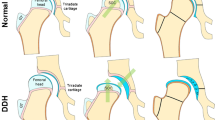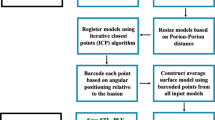Abstract
We hypothesized that subjects with hyperostosis frontalis interna (HFI), which represents local, endocranial thickening of the frontal bone, would express extra-calvarial manifestations of this condition. Therefore, we compared femoral bone mineral density, geometry, and microarchitecture of males and females with HFI to those without this condition as well as between males and females with HFI. The sample was taken from human donor cadavers, 38 males (19 with and 19 without HFI) and 34 females (17 with and 17 without HFI) that were age-matched within the same sex. The specimens of femoral bones were scanned using microcomputed tomography and dual-energy X-ray absorptiometry (DXA). Parameters of hip structure analysis (HSA) were calculated from data derived from DXA scans. Females with HFI had increased cortical bone volume fraction and their cortical bone was less porous compared to females without HFI. Males with HFI showed microarchitectural differences only with the trabecular bone. They had increased bone volume fraction and decreased trabecular separation compared to males without HFI, although with borderline significance. These microarchitectural changes did not have significant impact on femoral geometry and bone mineral density. The same, still unknown etiological factor behind HFI might be inducing changes at the level of bone microarchitecture at a remote skeletal site (femoral bone), in both sexes. These alterations still do not have the magnitude to induce obvious, straightforward overall increase of bone mineral density measured by DXA. HFI could be a systemic phenomenon that affects both males and females in a similar manner.


Similar content being viewed by others
References
Western AG, Bekvalac JJ (2017) Hyperostosis frontalis interna in female historic skeletal populations: age, sex hormones and the impact of industrialization. Am J Phys Anthropol 162:501–515. https://doi.org/10.1002/ajpa.23133
Hershkovitz I, Greenwald C, Rothschild BM et al (1999) Hyperostosis frontalis interna: an anthropological perspective. Am J Phys Anthropol 109:303–325. https://doi.org/10.1002/(SICI)1096-8644(199907)109:3<303:AID-AJPA3>3.0.CO;2-I
Nikolić S, Djonić D, Živković V et al (2010) Rate of occurrence, gross appearance, and age relation of hyperostosis frontalis interna in females: a prospective autopsy study. Am J Forensic Med Pathol 31:205–207. https://doi.org/10.1097/PAF.0b013e3181d3dba4
May H, Peled N, Dar G et al (2010) Hyperostosis frontalis interna and androgen suppression. Anat Rec 293:1333–1336. https://doi.org/10.1002/ar.21175
Salmi A, Voutilainen A, Holsti IR, Unnerus CE (1962) Hyperostosis cranii in a normal population. Am J Roentgenol Radium Ther Nucl Med 87:1032–1040
Dann S (1951) Metabolic craniopathy: a review of the literature with report of a case with diabetes mellitus. Ann Intern Med 34:163–202
Moore (1944) Metabolic craniopathy. Am J Roentgenol 35:30–39
Fulton JD, Shand J, Ritchie D, McGhee J (1990) Hyperostosis frontalis interna, acromegaly and hyperprolactinaemia. Postgrad Med J 66:16–19. https://doi.org/10.1136/pgmj.66.771.16
May H, Mali Y, Dar G et al (2012) Intracranial volume, cranial thickness, and hyperostosis frontalis interna in the elderly. Am J Hum Biol 24:812–819. https://doi.org/10.1002/ajhb.22325
Almeida M, Laurent MR, Dubois V et al (2017) Estrogens and androgens in skeletal physiology and pathophysiology. Physiol Rev 97:135–187. https://doi.org/10.1152/physrev.00033.2015
Khosla S, Monroe DG (2018) Regulation of bone metabolism by sex steroids. Cold Spring Harb Perspect Med. https://doi.org/10.1101/cshperspect.a031211
Kollin E, Feher T (1986) Androgens, bone mineral content and hyperostosis frontalis interna in pre-menopausal women. Exp Clin Endocrinol 87:211–214. https://doi.org/10.1055/s-0029-1210546
Djonic D, Bracanovic D, Rakocevic Z et al (2016) Hyperostosis frontalis interna in postmenopausal women—possible relation to osteoporosis. Women Heal 56:994–1007. https://doi.org/10.1080/03630242.2016.1178685
Cui WQ, Won YY, Baek MH et al (2008) Age-and region-dependent changes in three-dimensional microstructural properties of proximal femoral trabeculae. Osteoporos Int 19:1579–1587. https://doi.org/10.1007/s00198-008-0601-7
Beck TJ, Ruff CB, Warden KE et al (1990) Predicting femoral neck strength from bone mineral data. A structural approach. Invest Radiol 25:6–18. https://doi.org/10.1097/00004424-199001000-00004
Kanis JA, Johansson H, Oden A, McCloskey EV (2012) The distribution of FRAX((R))-based probabilities in women from Japan. J Bone Miner Metab 30:700–705. https://doi.org/10.1007/s00774-012-0371-3
Cvetkovic D, Nikolic S, Brkovic V, Zivkovic V (2019) Hyperostosis frontalis interna as an age-related phenomenon - Differences between males and females and possible use in identification. Sci Justice 59:172–176. https://doi.org/10.1016/j.scijus.2018.09.005
Sebastian A, Loots GG (2018) Genetics of Sost/SOST in sclerosteosis and van Buchem disease animal models. Metabolism 80:38–47. https://doi.org/10.1016/j.metabol.2017.10.005
Delgado-Calle J, Sato AY, Bellido T (2017) Role and mechanism of action of sclerostin in bone. Bone 96:29–37. https://doi.org/10.1016/j.bone.2016.10.007
Sharifi M, Ereifej L, Lewiecki EM (2015) Sclerostin and skeletal health. Rev Endocr Metab Disord 16:149–156. https://doi.org/10.1007/s11154-015-9311-6
Parr BA, McMahon AP (1995) Dorsalizing signal Wnt-7a required for normal polarity of D-V and A-P axes of mouse limb. Nature 374:350–353. https://doi.org/10.1038/374350a0
Niemann S, Zhao C, Pascu F et al (2004) Homozygous WNT3 mutation causes tetra-amelia in a large consanguineous family. Am J Hum Genet 74:558–563. https://doi.org/10.1086/382196
Bian P, Li X, Ying Q et al (2015) Factors associated with low femoral neck bone mineral density in very elderly Chinese males. Arch Gerontol Geriatr 61:484–488. https://doi.org/10.1016/j.archger.2015.08.010
Cauley JA, Ewing SK, Taylor BC et al (2010) Sex steroid hormones in older men: longitudinal associations with 4.5-year change in hip bone mineral density–the osteoporotic fractures in men study. J Clin Endocrinol Metab 95:4314–4323. https://doi.org/10.1210/jc.2009-2635
Lou Bonnick S (2007) HSA: beyond BMD with DXA. Bone 41:9–12. https://doi.org/10.1016/j.bone.2007.03.007
Beck TJ (2007) Extending DXA beyond bone mineral density: understanding hip structure analysis. Curr Osteoporos Rep 5:49–55. https://doi.org/10.1007/s11914-007-0002-4
Beck TJ, Looker AC, Ruff CB et al (2000) Structural trends in the aging femoral neck and proximal shaft: analysis of the Third National Health and Nutrition Examination Survey dual-energy X-ray absorptiometry data. J Bone Miner Res 15:2297–2304
Saukko P, Knight B (2004) Knight’s Forensic pathology. Arnold, London
Madea B (2014) Handbook of forensic medicine. Wiley Blackwell, Chichester
Acknowledgements
Authors would like to thank Dr. Ivan Zaletel for graphical representation of data.
Funding
This work was supported by Ministry of Education, Science, and Technological Development of the Republic of Serbia [Grant Number 45005].
Author information
Authors and Affiliations
Contributions
DC involved in collecting resources, investigation, formal analysis, and writing—original draft; JJ performed investigation and formal analysis; PM did methodology and visualization; DD contributed to mmethodology and writing—review & editing; MD performeed project administration, conceptualization, and methodology; MI did investigation and formal analysis; and SN and VZ involved in collecting resources, supervision, conceptualization, methodology, and writing—rreview & editing.
Corresponding author
Ethics declarations
Conflict of interest
All authors declare that they have no conflicts of interest.
Ethical Approval
This study was performed in line with the principles of the Declaration of Helsinki. Approval was granted by the Ethics Committee of the School of Medicine, University of Belgrade (Approval No. 2650/XII-14).
Additional information
Publisher's Note
Springer Nature remains neutral with regard to jurisdictional claims in published maps and institutional affiliations.
Rights and permissions
About this article
Cite this article
Cvetković, D., Jadžić, J., Milovanović, P. et al. Comparative Analysis of Femoral Macro- and Micromorphology in Males and Females With and Without Hyperostosis Frontalis Interna: A Cross-Sectional Cadaveric Study. Calcif Tissue Int 107, 464–473 (2020). https://doi.org/10.1007/s00223-020-00740-0
Received:
Accepted:
Published:
Issue Date:
DOI: https://doi.org/10.1007/s00223-020-00740-0




